Effective Reinforcement of Visible Light Photocatalytic and Gas Sensing Characteristics of Nanocrystalline TiO2: Gd-Based Nb and Mo Dopants
Abstract
:1. Introduction
2. Results and Discussion
2.1. X-ray Diffraction (XRD)
2.2. Band Gap and Optical Features
2.3. Scanning Electron Microscope (SEM)
2.4. Depollution of Organic Pollutants
2.5. Gas Sensing Properties
3. Experimental
3.1. Synthesis of TiO2-Based Compositions
3.2. Characterization and Measurements
Funding
Institutional Review Board Statement
Informed Consent Statement
Data Availability Statement
Acknowledgments
Conflicts of Interest
References
- Dhall, S.; Mehta, B.; Tyagi, A.; Sood, K. A review on environmental gas sensors: Materials and technologies. Sens. Int. 2021, 2, 100116. [Google Scholar] [CrossRef]
- Rahayu, F.; Mustafa, I.; Marjani; Rochman, F.; Qazi, R.A.; Zeb, K.; Ullah, N. Newly Isolated Ligninolytic Bacteria and Its Applications for Multiple Dye Degradation. Water Air Soil Pollut. 2023, 234, 359. [Google Scholar] [CrossRef]
- Iqbal, M.; Ibrar, A.; Ali, A.; Hussain, S.; Shad, S.; Ullah, S.; Alshahrani, T.; Hakami, J.; Khan, F.; Thebo, K.H. Facile Synthesis of Mn doped Bi2S3 Photocatalyst for Efficient Degradation of Organic Dye under Visible-Light Irradiation. J. Mol. Struct. 2022, 1267, 133598. [Google Scholar] [CrossRef]
- Rehman, F.; Memon, F.H.; Ullah, S.; Mazumder, M.A.J.; Al-Ahmed, A.; Khan, F.; Thebo, K.H. Recent Development in Laminar Transition Metal Dichalcogenides-Based Membranes Towards Water Desalination: A Review. Chem. Rec. 2022, 22, e202200107. [Google Scholar] [CrossRef] [PubMed]
- Garg, A.; Chopra, L. Dye Waste: A significant environmental hazard. Mater. Today Proc. 2022, 48, 1310–1315. [Google Scholar] [CrossRef]
- Lellis, B.; Fávaro-Polonio, C.Z.; Pamphile, J.A.; Polonio, J.C. Effects of textile dyes on health and the environment and bioremediation potential of living organisms. Biotechnol. Res. Innov. 2019, 3, 275–290. [Google Scholar] [CrossRef]
- Al-Tohamy, R.; Ali, S.S.; Li, F.; Okasha, K.M.; Mahmoud, Y.A.-G.; Elsamahy, T.; Jiao, H.; Fu, Y.; Sun, J. A critical review on the treatment of dye-containing wastewater: Ecotoxicological and health concerns of textile dyes and possible remediation approaches for environmental safety. Ecotoxicol. Environ. Saf. 2022, 231, 113160. [Google Scholar] [CrossRef] [PubMed]
- Hosny, N.M.; Gomaa, I.; Elmahgary, M.G. Adsorption of polluted dyes from water by transition metal oxides: A review. Appl. Surf. Sci. Adv. 2023, 15, 100395. [Google Scholar] [CrossRef]
- Senasu, T.; Youngme, S.; Hemavibool, K.; Nanan, S. Sunlight-driven photodegradation of oxytetracycline antibiotic by BiVO4 photocatalyst. J. Solid State Chem. 2021, 297, 122088. [Google Scholar] [CrossRef]
- Alkaykh, S.; Mbarek, A.; Ali-Shattle, E.E. Photocatalytic degradation of methylene blue dye in aqueous solution by MnTiO3 nanoparticles under sunlight irradiation. Heliyon 2020, 6, e03663. [Google Scholar] [CrossRef] [PubMed]
- Atri, A.; Echabaane, M.; Bouzidi, A.; Harabi, I.; Soucase, B.M.; Ben Chaâbane, R. Green synthesis of copper oxide nanoparticles using Ephedra Alata plant extract and a study of their antifungal, antibacterial activity and photocatalytic performance under sunlight. Heliyon 2023, 9, e13484. [Google Scholar] [CrossRef] [PubMed]
- Moriomoto, T.; Oka, R.; Minagawa, K.; Masui, T. Novel near-infrared reflective black inorganic pigment based on cerium vanadate. RSC Adv. 2022, 12, 16570–16575. [Google Scholar] [CrossRef] [PubMed]
- Kumari, H.; Sonia; Suman; Ranga, R.; Chahal, S.; Devi, S.; Sharma, S.; Kumar, S.; Kumar, P.; Kumar, S.; et al. A Review on Photocatalysis Used for Wastewater Treatment: Dye Degradation. Water Air Soil Pollut. 2023, 234, 349. [Google Scholar] [CrossRef] [PubMed]
- Xu, J.; Shen, J.; Jiang, H.; Yu, X.; Qureshi, W.A.; Maouche, C.; Gao, J.; Yang, J.; Liu, Q. Progress and challenges in full spectrum photocatalysts: Mechanism and photocatalytic applications. J. Ind. Eng. Chem. 2023, 119, 112–129. [Google Scholar] [CrossRef]
- Li, Y.; Li, L.; Gong, Y.; Bai, S.; Ju, H.; Wang, C.; Xu, Q.; Zhu, J.; Jiang, J.; Xiong, Y. Towards full-spectrum photocatalysis: Achieving a Z-scheme between Ag2S and TiO2 by engineering energy band alignment with interfacial Ag. Nano Res. 2015, 8, 3621–3629. [Google Scholar] [CrossRef]
- Goulart, S.; Nieves, L.J.J.; Bó, A.G.D.; Bernardin, A.M. Sensitization of TiO2 nanoparticles with natural dyes extracts for photocatalytic activity under visible light. Dye Pigment 2020, 182, 108654. [Google Scholar] [CrossRef]
- Dodoo-Arhin, D.; Asiedu, T.; Agyei-Tuffour, B.; Nyankson, E.; Obada, D.; Mwabora, J. Photocatalytic degradation of Rhodamine dyes using zinc oxide nanoparticles. Mater. Today Proc. 2021, 38, 809–815. [Google Scholar] [CrossRef]
- Raizada, P.; Sudhaik, A.; Patial, S.; Hasija, V.; Khan, A.A.P.; Singh, P.; Gautam, S.; Kaur, M.; Nguyen, V.-H. Engineering nanostructures of CuO-based photocatalysts for water treatment: Current progress and future challenges. Arab. J. Chem. 2020, 13, 8424–8457. [Google Scholar] [CrossRef]
- Elango, G.; Roopan, S.M. Efficacy of SnO2 nanoparticles toward photocatalytic degradation of methylene blue dye. J. Photochem. Photobiol. B 2016, 155, 34–38. [Google Scholar] [CrossRef] [PubMed]
- Ijaz, M.; Zafar, M. Titanium dioxide nanostructures as efficient photocatalyst: Progress, challenges and perspective. Int. J. Energy Res. 2020, 45, 3569–3589. [Google Scholar] [CrossRef]
- Ge, Y.; Luo, H.; Huang, J.; Zhang, Z. Visible-light-active TiO2 photocatalyst for efficient photodegradation of organic dyes. Opt. Mater. 2020, 115, 111058. [Google Scholar] [CrossRef]
- Etacheri, V.; Di Valentin, C.; Schneider, J.; Bahnemann, D.; Pillai, S.C. Visible-light activation of TiO2 photocatalysts: Advances in theory and experiments. J. Photochem. Photobiol. C Photochem. Rev. 2015, 25, 1–29. [Google Scholar] [CrossRef]
- Ranjith, R.; Renganathan, V.; Chen, S.-M.; Selvan, N.S.; Rajam, P.S. Green synthesis of reduced graphene oxide supported TiO2/Co3O4 nanocomposite for photocatalytic degradation of methylene blue and crystal violet. Ceram. Int. 2019, 45, 12926–12933. [Google Scholar] [CrossRef]
- Huo, R.; Yang, J.-Y.; Liu, Y.-Q.; Liu, H.-F.; Li, X.; Xu, Y.-H. Preparation of W and N, S-codoped titanium dioxide with enhanced photocatalytic activity under visible light irradiation. Mater. Res. Bull. 2016, 76, 72–78. [Google Scholar] [CrossRef]
- Chobba, M.B.; Messaoud, M.; Weththimuni, M.L.; Bouaziz, J.; Licchelli, M.; De Leo, F.; Urzì, C. Preparation and characterization of photocatalytic Gd-doped TiO2 nanoparticles for water treatment. Environ. Sci. Pollut. Res. 2019, 26, 32734–32745. [Google Scholar] [CrossRef]
- Li, R.; Yang, J.; Xu, S.; Zhou, Y.; Wang, X.; Peng, H.; Du, J. Preparation of Gd-Doped TiO2 nanotube arrays by anodization method and its photocatalytic activity for Methyl orange degradation. Catalysts 2020, 10, 298. [Google Scholar] [CrossRef]
- Xu, J.; Ao, Y.; Fu, D.; Yuan, C. Synthesis of Gd-doped TiO2 nanoparticles under mild condition and their photocatalytic activity. Colloids Surfaces A Physicochem. Eng. Asp. 2009, 334, 107–111. [Google Scholar] [CrossRef]
- Bagwan, U.R.; Shaikh, I.N.; Malladi, R.S.; Harihar, A.L.; Hunagund, S.M. Effect of titanium dioxide and gadolinium dopants on photocatalytic behavior for acriflavine dye. J. Rare Earths 2018, 38, 234–240. [Google Scholar] [CrossRef]
- Wang, Z.; Zhu, L.; Wang, J.; Zhuang, R.; Mu, P.; Wang, J.; Yan, W. Advances in functional guest materials for resistive gas sensors. RSC Adv. 2022, 12, 24614–24632. [Google Scholar] [CrossRef] [PubMed]
- Jiang, L.; Lv, S.; Tang, W.; Zhao, L.; Wang, C.; Wang, J.; Wang, T.; Guo, X.; Liu, F.; Wang, C.; et al. YSZ-based acetone sensor using a Cd2SnO4 sensing electrode for exhaled breath detection in medical diagnosis. Sens. Actuators B Chem. 2021, 345, 130321. [Google Scholar] [CrossRef]
- Choi, N.-J.; Lee, Y.-S.; Kwak, J.-H.; Park, J.-S.; Park, K.-B.; Shin, K.-S.; Park, H.-D.; Kim, J.-C.; Huh, J.-S.; Lee, D.-D. Chemical warfare agent sensor using MEMS structure and thick film fabrication method. Sens. Actuators B 2005, 108, 177–183. [Google Scholar] [CrossRef]
- Vasiliev, A.; Malyshev, V. Sensors for the ultra-fast monitoring of explosive gas concentrations. Sens. Actuators B Chem. 2013, 189, 260–267. [Google Scholar] [CrossRef]
- Wang, Z.; Wang, Y.; Yan, J.; Liu, B.; Chen, Y.; Tian, Y. Metal–organic framework-based photonic crystal platforms for gas sensing: A review. Mater. Adv. 2022, 3, 6728–6741. [Google Scholar] [CrossRef]
- Souissi, R.; Bouricha, B.; Bouguila, N.; El Mir, L.; Labidi, A.; Abderrabba, M. Chemical VOC sensing mechanism of sol–gel ZnO pellets and linear discriminant analysis for instantaneous selectivity. RSC Adv. 2023, 13, 20651–20662. [Google Scholar] [CrossRef]
- Tan, Y.; Zhang, J. Highly sensitive ethanol gas sensors based on Co-doped SnO2 nanobelts and pure SnO2 nanobelts. Phys. E Low-Dimens. Syst. Nanostruct. 2023, 147, 115604. [Google Scholar] [CrossRef]
- Nur’Aini, A.; Oh, I. Volatile organic compound gas sensors based on methylammonium lead iodide perovskite operating at room temperature. RSC Adv. 2020, 10, 12982–12987. [Google Scholar] [CrossRef] [PubMed]
- Silva, E.A.; Braunger, M.L.; Gregori, A.; Olivati, C.A. Volatile organic compounds detection by electrical sensors using polyalkylthiophene-based Langmuir–Blodgett films. SN Appl. Sci. 2019, 1, 200. [Google Scholar] [CrossRef]
- Alzeer, J.; Hadeed, K.A. Ethanol and its Halal status in food industries. Trends Food Sci. Technol. 2016, 58, 14–20. [Google Scholar] [CrossRef]
- Din, S.U.; Haq, M.U.; Khatoon, R.; Chen, X.; Li, L.; Zhang, M.; Zhu, L. A novel ethanol gas sensor based on α-Bi2Mo3O12/Co3O4 nanotube-decorated particles. RSC Adv. 2020, 10, 21940–21953. [Google Scholar] [CrossRef] [PubMed]
- Li, J.; Ding, Q.; Mo, X.; Zou, Z.; Cheng, P.; Li, Y.; Sun, K.; Fu, Y.; Wang, Y.; He, D. A highly stable and sensitive ethanol sensor based on Ru-decorated 1D WO3 nanowires. RSC Adv. 2021, 11, 39130–39141. [Google Scholar] [CrossRef]
- Wang, Q.; Bai, J.; Hu, Q.; Hao, J.; Cheng, X.; Li, J.; Xie, E.; Wang, Y.; Pan, X. W-doped NiO as a material for selective resistive ethanol sensors. Sens. Actuators B Chem. 2020, 308, 127668. [Google Scholar] [CrossRef]
- Jahanshahi, P.; Wei, Q.; Jie, Z.; Zalnezhad, E. Designing a Non-invasive Surface Acoustic Resonator for Ultra-high Sensitive Ethanol Detection for an On-the-spot Health Monitoring System. Biotechnol. Bioprocess Eng. 2018, 23, 394–404. [Google Scholar] [CrossRef]
- Nechita, V.; Schoonman, J.; Musat, V. Ethanol and methanol sensing characteristics of Nb-doped TiO2 porous thin films. Phys. Status Solidi 2012, 209, 153–159. [Google Scholar] [CrossRef]
- Garzella, C.; Bontempi, E.; Depero, L.; Vomiero, A.; Della Mea, G.; Sberveglieri, G. Novel selective ethanol sensors: W/TiO2 thin films by sol–gel spin-coating. Sens. Actuators B Chem. 2003, 93, 495–502. [Google Scholar] [CrossRef]
- Phanichphant, S.; Liewhiran, C.; Wetchakun, K.; Wisitsoraat, A.; Tuantranont, A. Flame-Made Nb-Doped TiO2 Ethanol and Acetone Sensors. Sensors 2011, 11, 472–484. [Google Scholar] [CrossRef] [PubMed]
- Choi, J.; Sudhagar, P.; Lakshmipathiraj, P.; Lee, J.W.; Devadoss, A.; Lee, S.; Song, T.; Hong, S.; Eito, S.; Terashima, C.; et al. Three-dimensional Gd-doped TiO2 fibrous photoelectrodes for efficient visible light-driven photocatalytic performance. RSC Adv. 2014, 4, 11750–11757. [Google Scholar] [CrossRef]
- Kaleji, B.K.; Sarraf-Mamoory, R.; Fujishima, A. Influence of Nb dopant on the structural and optical properties of nanocrystalline TiO2 thin films. Mater. Chem. Phys. 2012, 132, 210–215. [Google Scholar] [CrossRef]
- Wang, S.; Bai, L.; Sun, H.; Jiang, Q.; Lian, J. Structure and photocatalytic property of Mo-doped TiO2 nanoparticles. Powder Technol. 2013, 244, 9–15. [Google Scholar] [CrossRef]
- Karunakaran, C.; Vinayagamoorthy, P.; Jayabharathi, J. Enhanced photocatalytic activity of magnetically separable bactericidal CuFe2O4-embedded Ag-deposited ZnO nanosheets. RSC Adv. 2016, 6, 1782–1791. [Google Scholar] [CrossRef]
- Gorgani, M.; Kaleji, B.K. Structural, photocatalytic and surface analysis of Nb/Ag codoped TiO2 mesoporous nanoparticles. J. Sol-Gel Sci. Technol. 2020, 96, 728–741. [Google Scholar] [CrossRef]
- Wang, Z.; Li, J.; Tang, F.; Lin, J.; Jin, Z. Polydopamine nanotubes-templated synthesis of TiO2 and its photocatalytic performance under visible light. RSC Adv. 2017, 7, 23535–23542. [Google Scholar] [CrossRef]
- DeSario, P.A.; Graham, M.E.; Gelfand, R.M.; Gray, K.A. The effect of Nb substitution on synthesis and photo-response of TiO2 thin films prepared by direct current magnetron sputtering. Thin Solid Films 2011, 519, 3562–3568. [Google Scholar] [CrossRef]
- Huang, J.-G.; Guo, X.-T.; Wang, B.; Li, L.-Y.; Zhao, M.-X.; Dong, L.-L.; Liu, X.-J.; Huang, Y.-T. Synthesis and Photocatalytic Activity of Mo-Doped TiO2 Nanoparticles. J. Spectrosc. 2015, 2015, 681850. [Google Scholar] [CrossRef]
- Jiang, G.; Wei, Z.; Chen, H.; Du, X.; Li, L.; Liu, Y.; Huang, Q.; Chen, W. Preparation of novel carbon nanofibers with BiOBr and AgBr decoration for the photocatalytic degradation of rhodamine B. RSC Adv. 2015, 5, 30433–30437. [Google Scholar] [CrossRef]
- Souissi, R.; Bouguila, N.; Bouricha, B.; Vázquez-Vázquez, C.; Bendahan, M.; Labidi, A. Thickness effect on VOC sensing properties of sprayed In2S3 films. RSC Adv. 2020, 10, 18841–18852. [Google Scholar] [CrossRef] [PubMed]
- Eom, N.S.A.; Cho, H.-B.; Lim, H.-R.; Hwang, T.-Y.; Song, Y.; Choa, Y.-H. Ultrasensitive detection of low-ppm H2S gases based on palladium-doped porous silicon sensors. RSC Adv. 2018, 8, 29995–30001. [Google Scholar] [CrossRef] [PubMed]
- Poloju, M.; Jayababu, N.; Reddy, M.R. Improved gas sensing performance of Al doped ZnO/CuO nanocomposite based ammonia gas sensor. Mater. Sci. Eng. B 2018, 227, 61–67. [Google Scholar] [CrossRef]
- Hussain, S.; Amu-Darko, J.N.O.; Wang, M.; Alothman, A.A.; Ouladsmane, M.; Aldossari, S.A.; Khan, M.S.; Qiao, G.; Liu, G. CuO-decorated MOF derived ZnO polyhedral nanostructures for exceptional H2S gas detection. Chemosphere 2023, 317, 137827. [Google Scholar] [CrossRef] [PubMed]
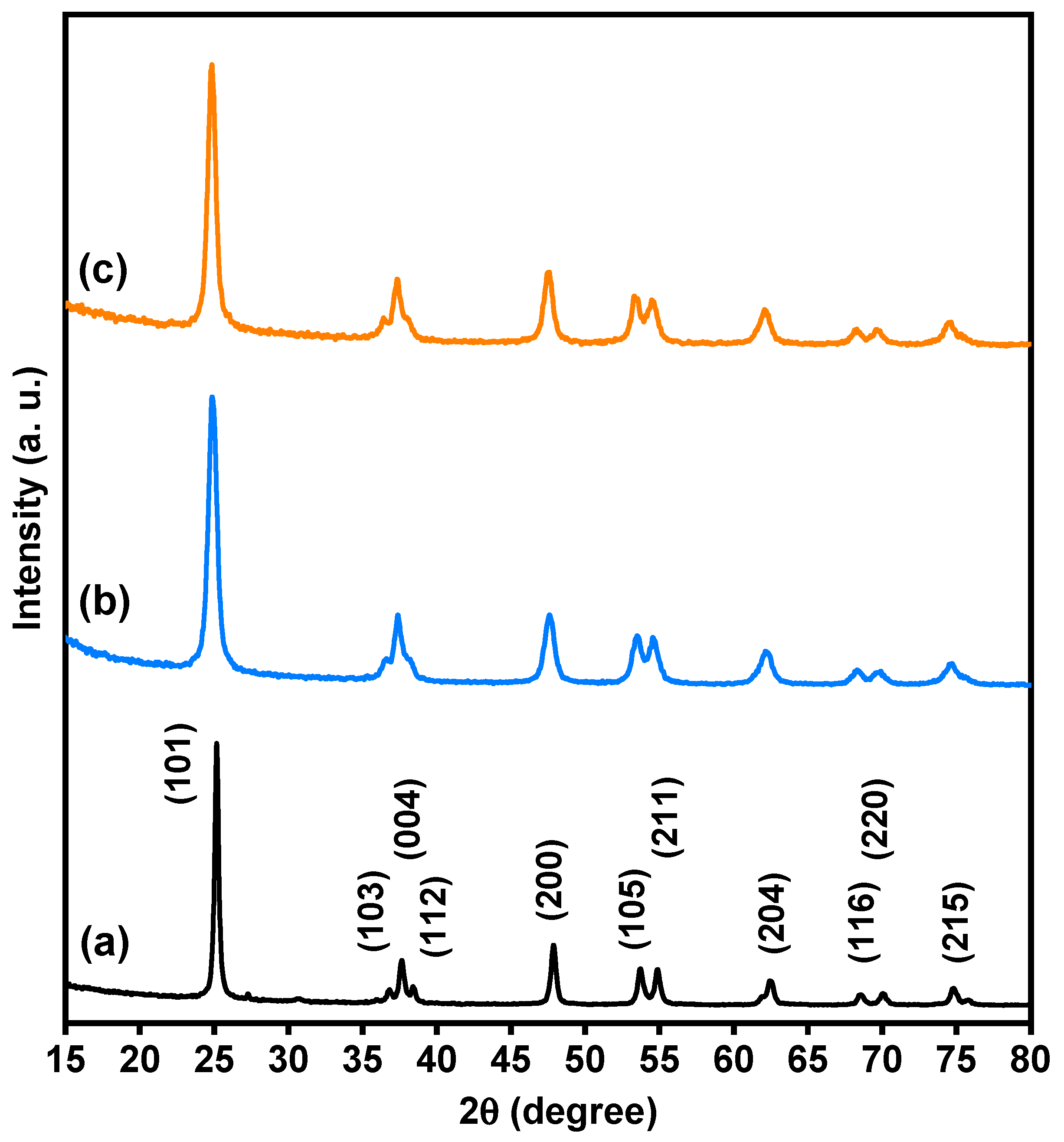
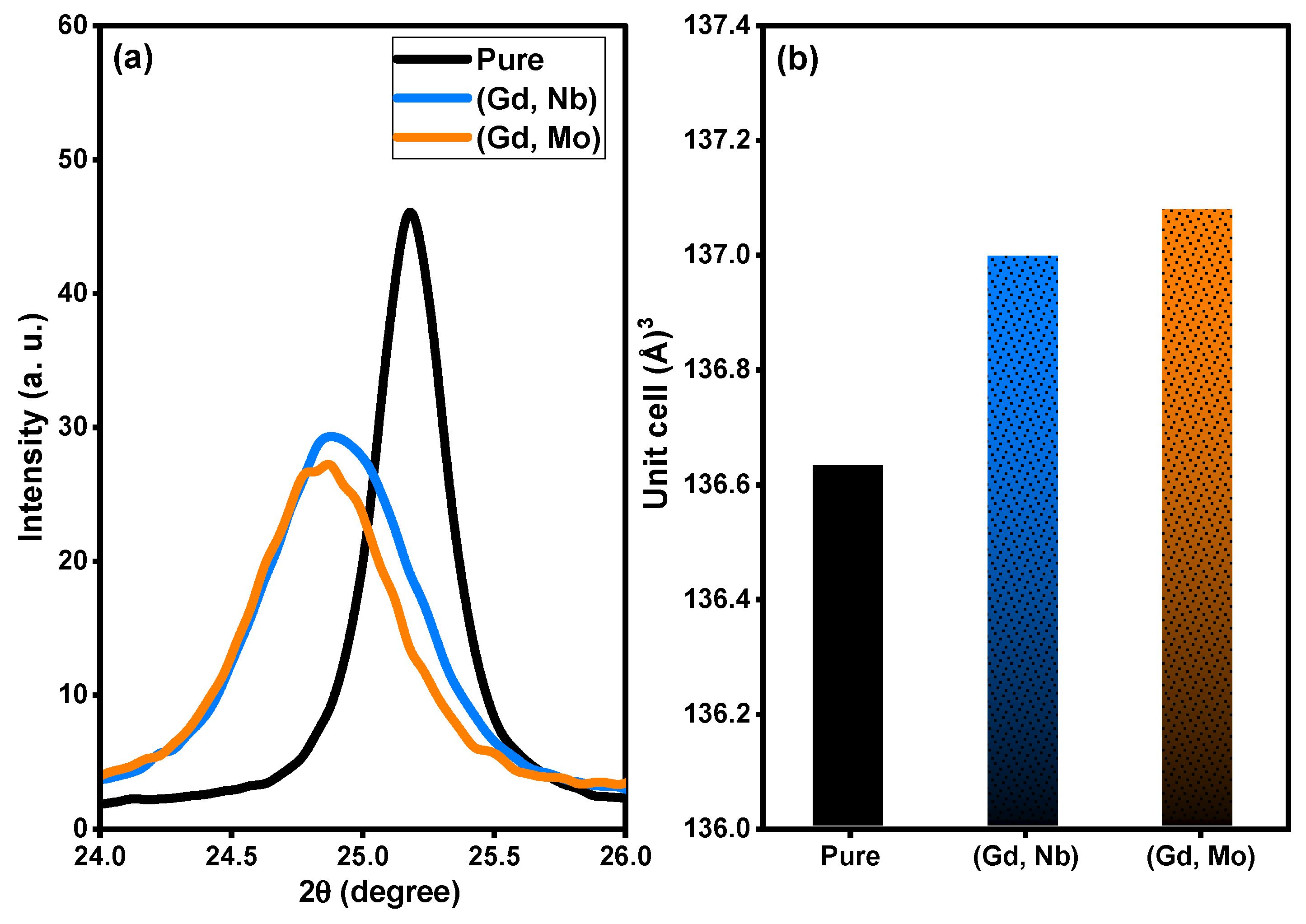
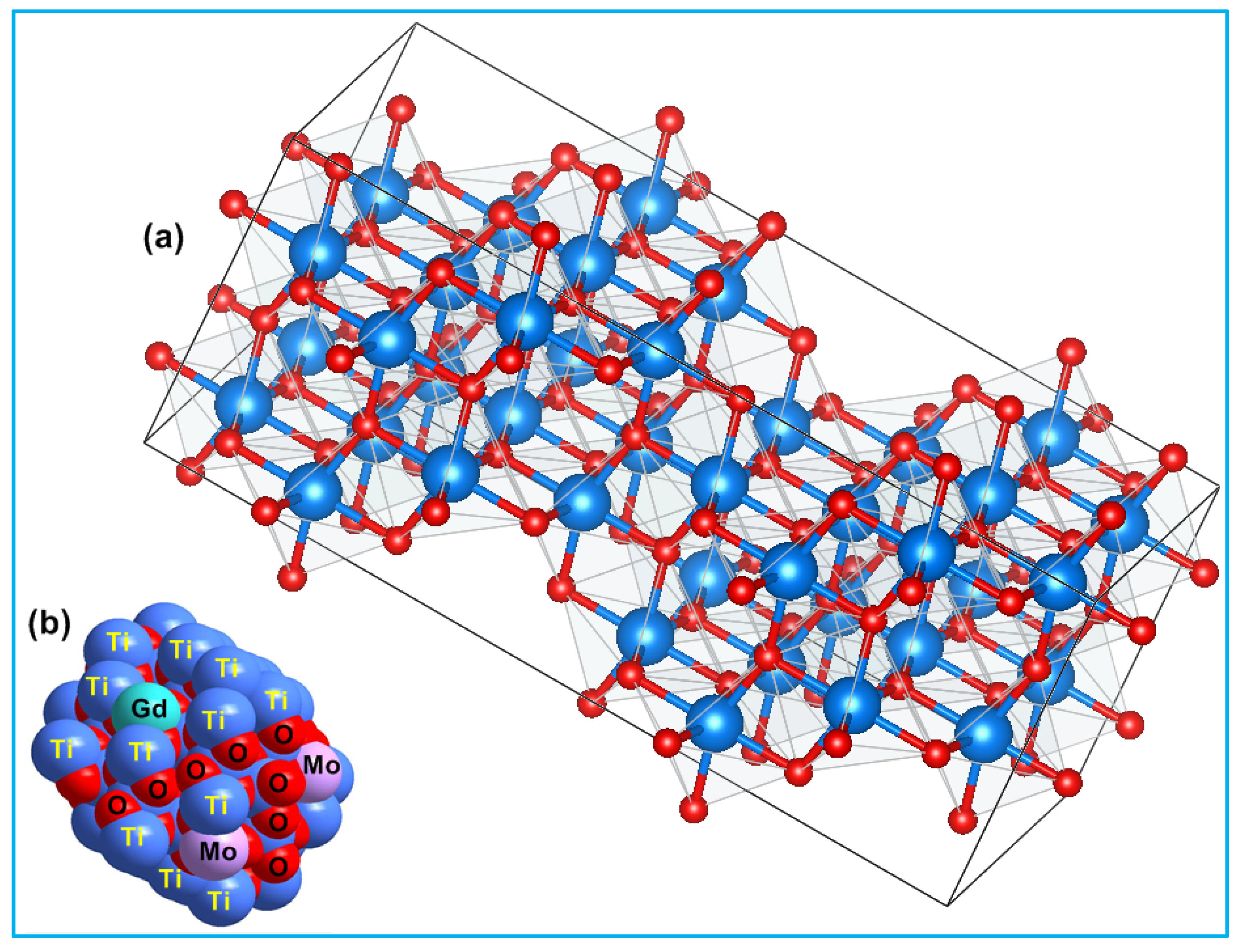

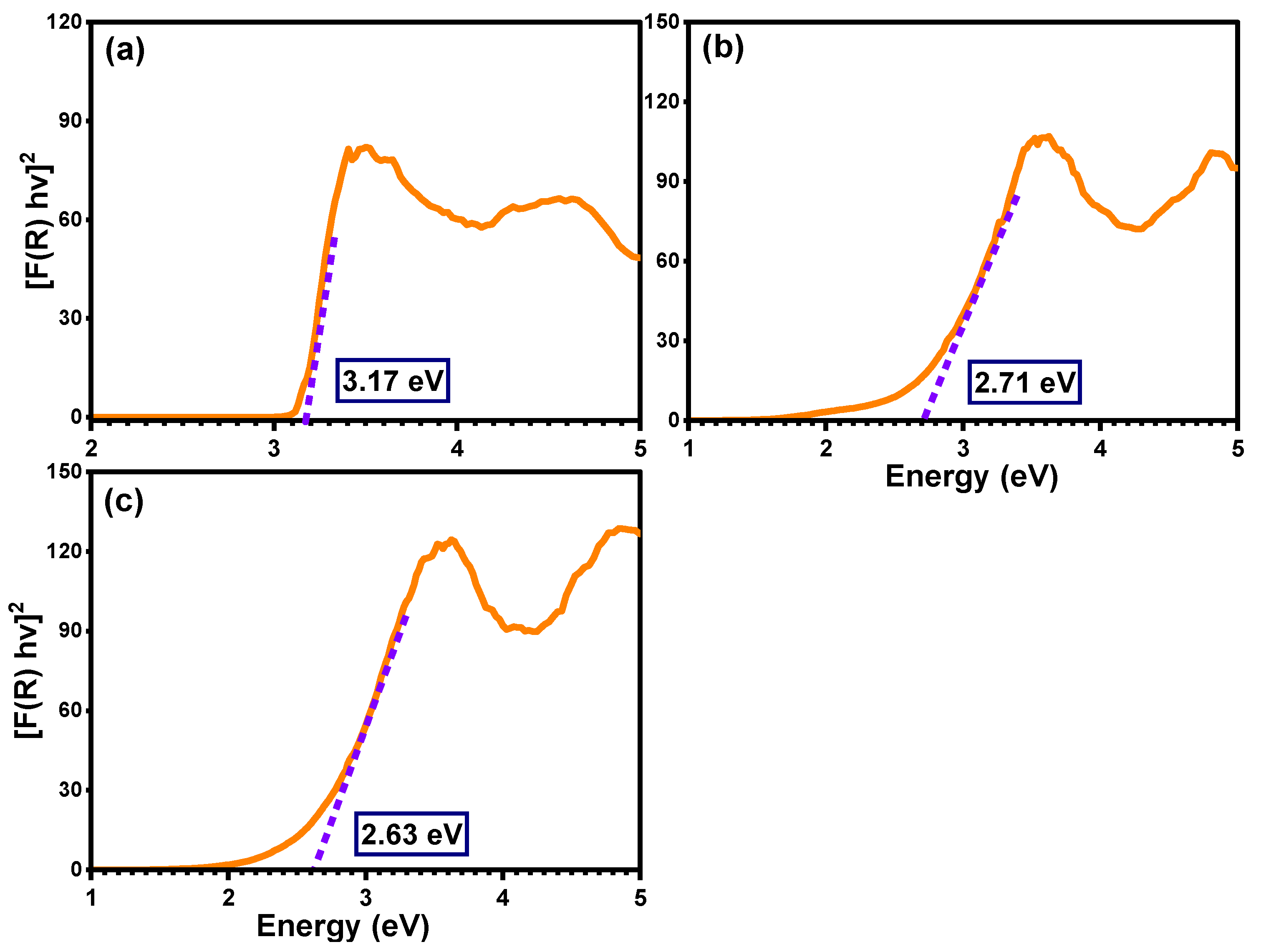


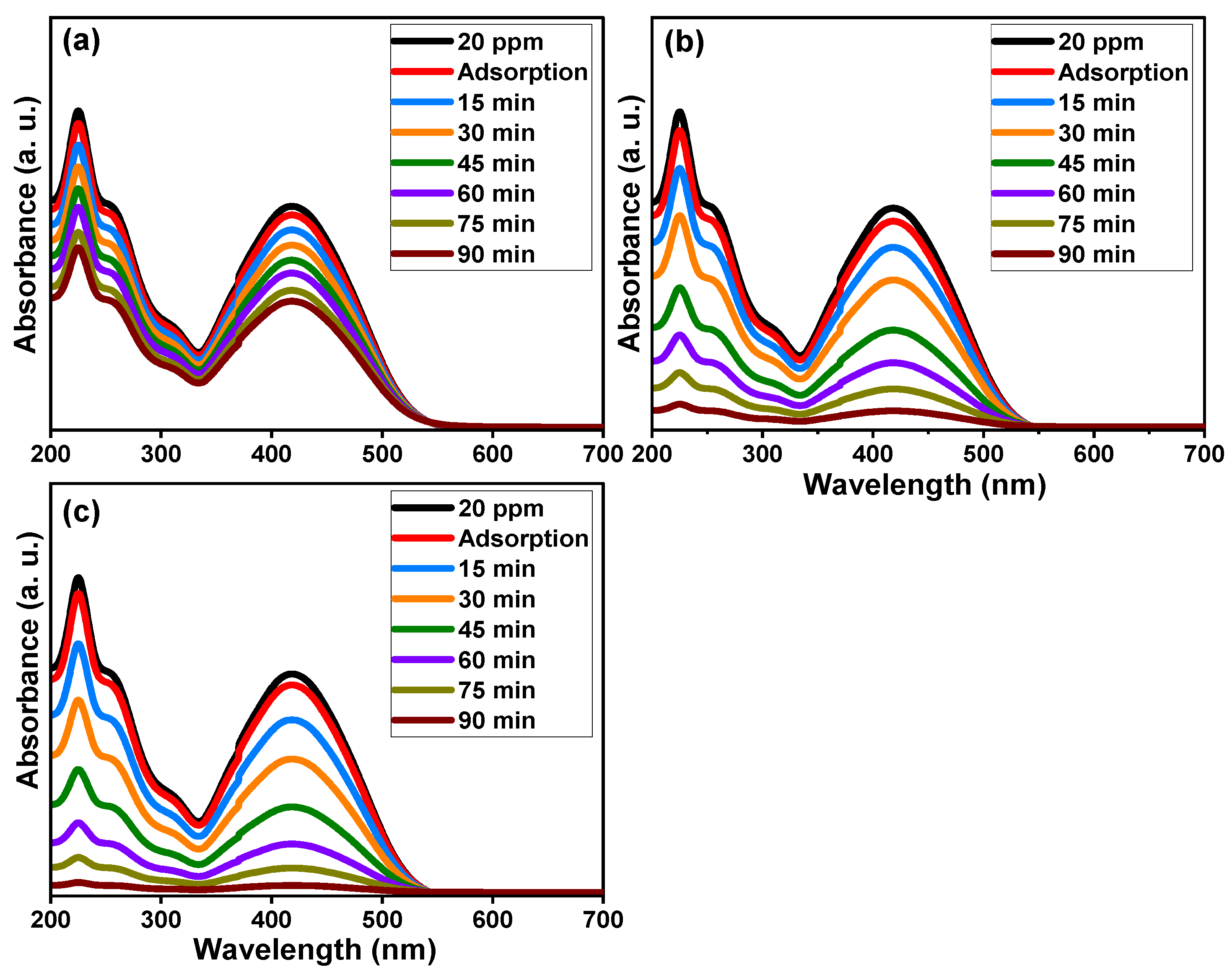
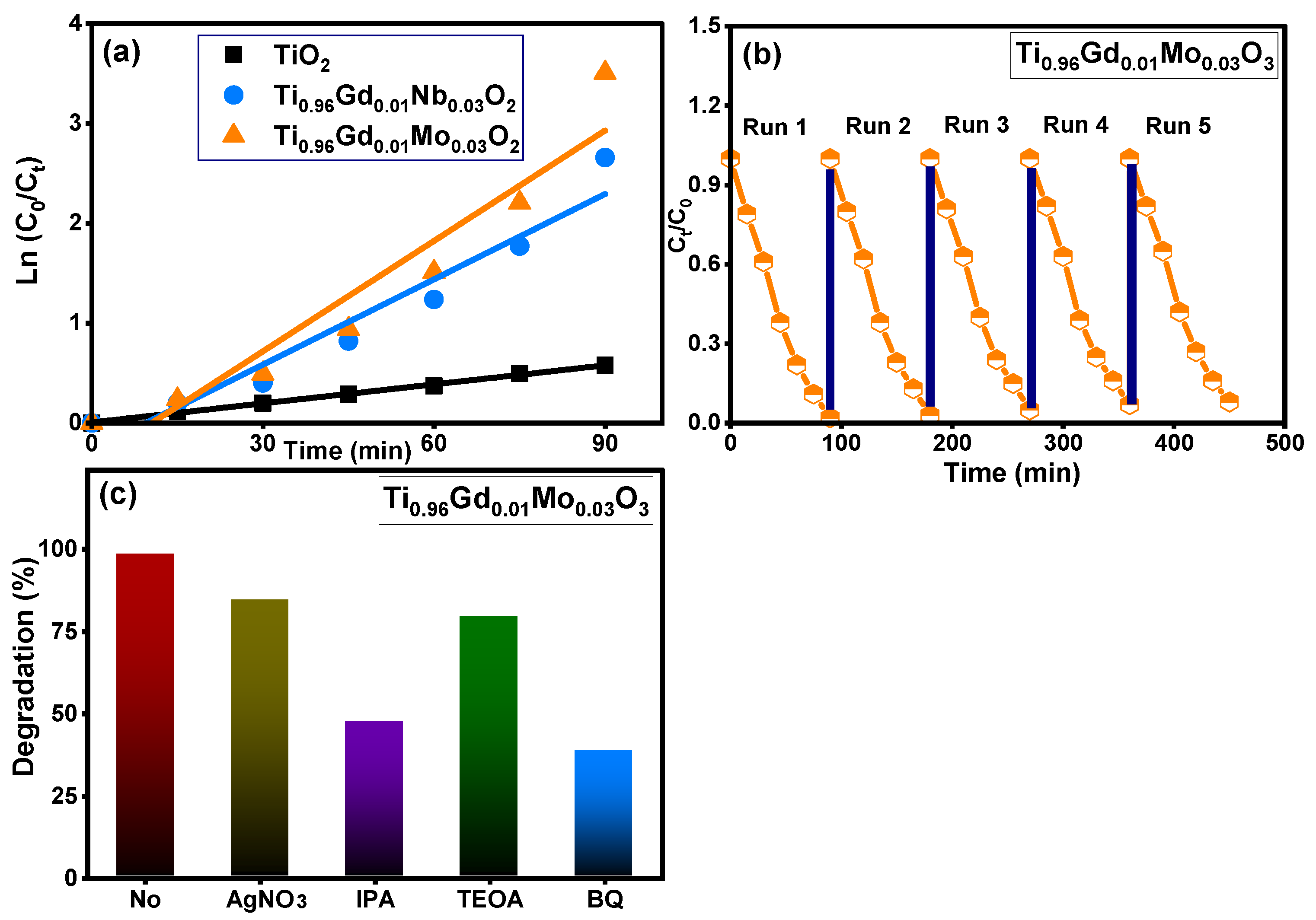
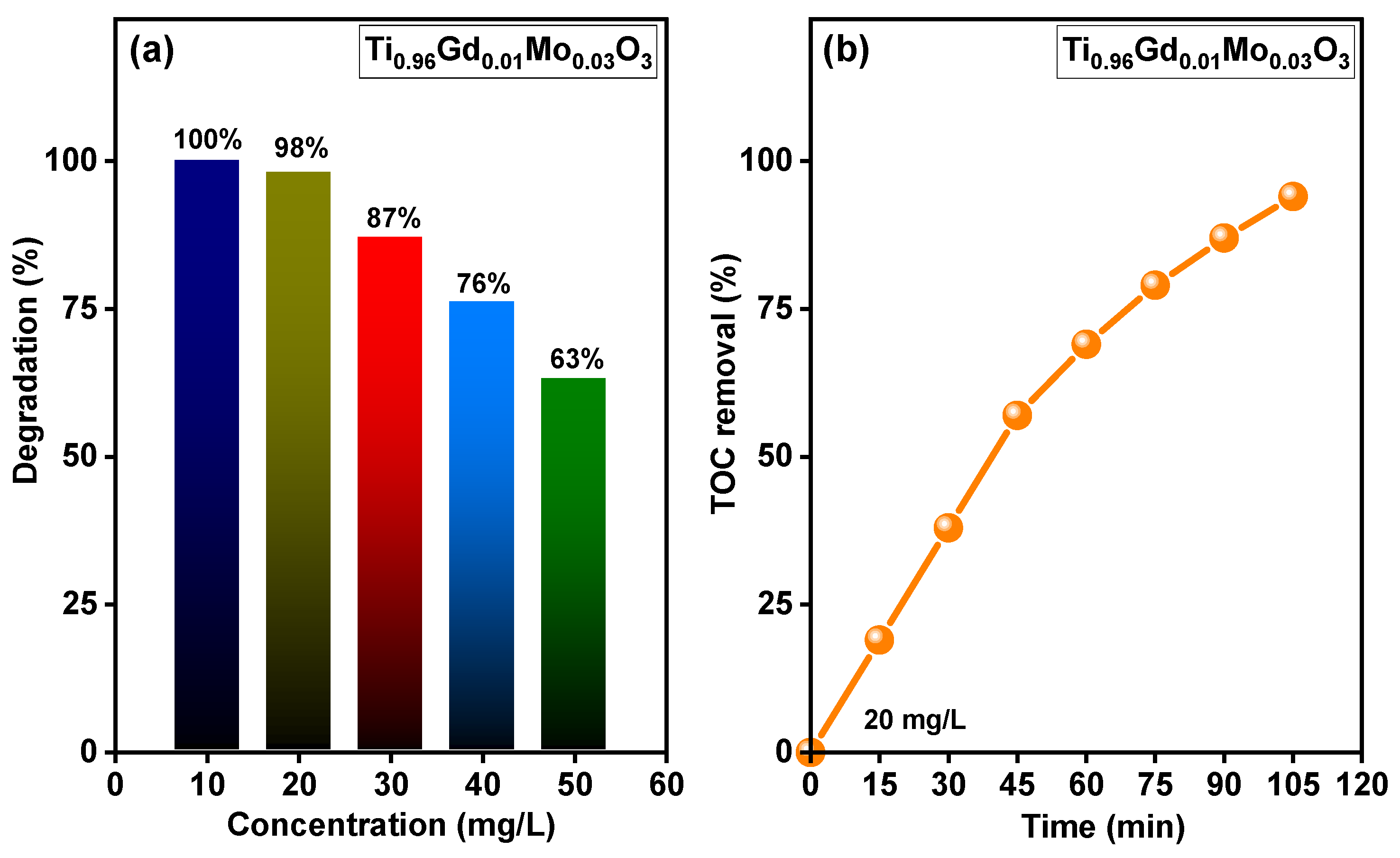
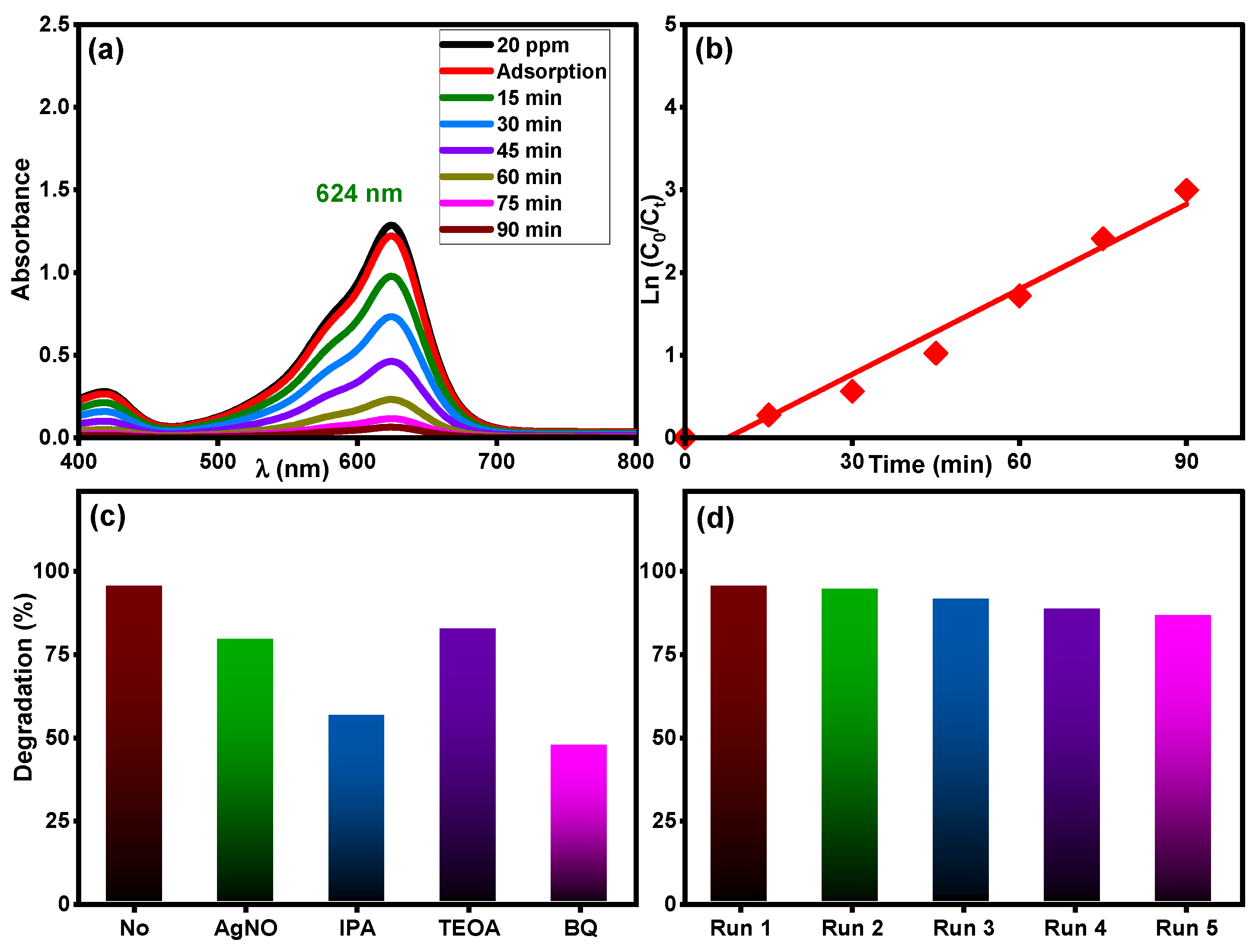

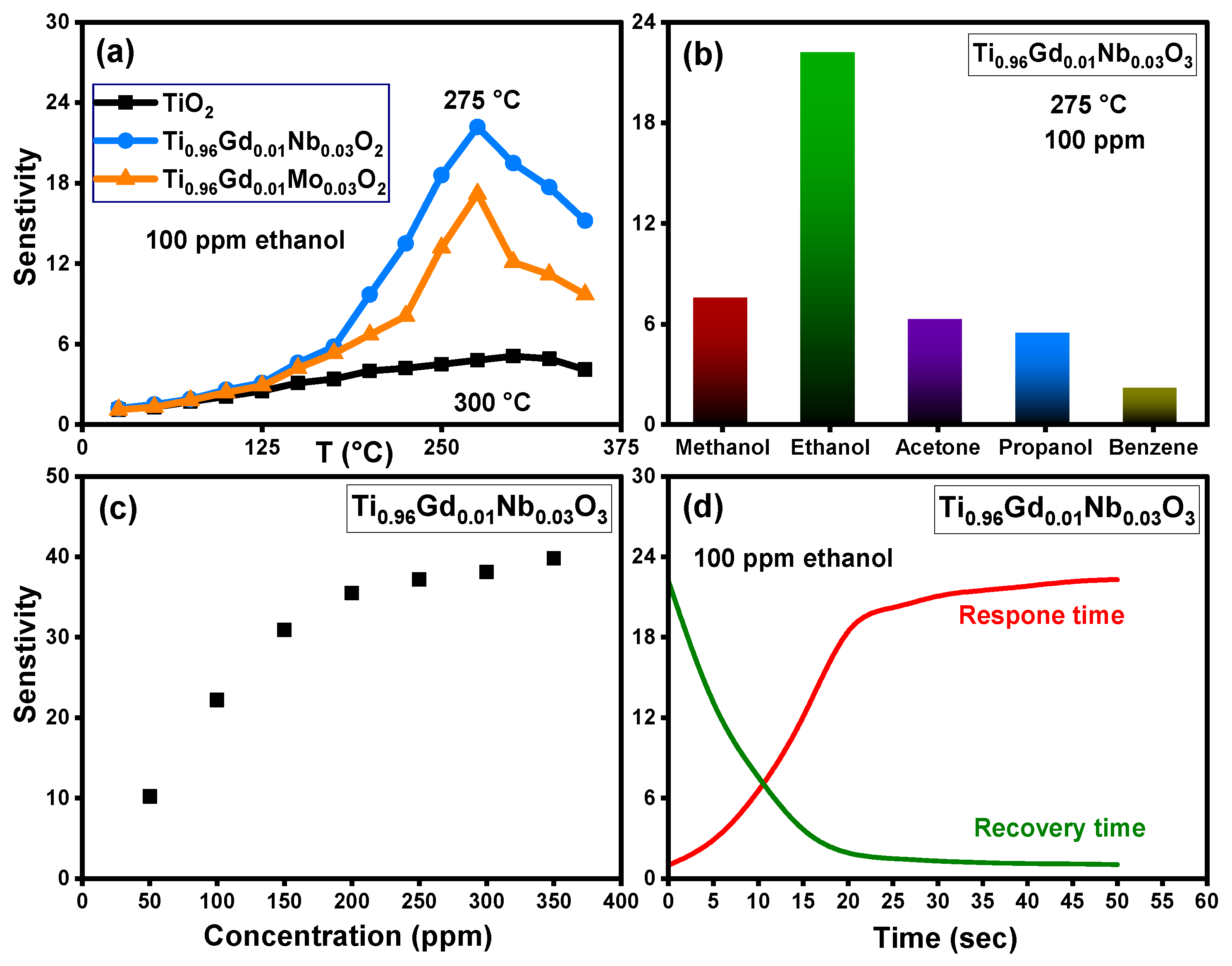
| Composition | Ti(OBu)₄ (mL) | Gd(NO3)3 (g) | NbCl5 (g) | MoCl5 (g) |
|---|---|---|---|---|
| TiO2 | 12.8 | - | - | - |
| (1% Gd, 3% Nb) | 12.276 | 0.1287 | 0.304 | - |
| (1% Gd, 3% Mo) | 12.276 | 0.1287 | - | 0.307 |
Disclaimer/Publisher’s Note: The statements, opinions and data contained in all publications are solely those of the individual author(s) and contributor(s) and not of MDPI and/or the editor(s). MDPI and/or the editor(s) disclaim responsibility for any injury to people or property resulting from any ideas, methods, instructions or products referred to in the content. |
© 2023 by the author. Licensee MDPI, Basel, Switzerland. This article is an open access article distributed under the terms and conditions of the Creative Commons Attribution (CC BY) license (https://creativecommons.org/licenses/by/4.0/).
Share and Cite
Alsulaim, G.M. Effective Reinforcement of Visible Light Photocatalytic and Gas Sensing Characteristics of Nanocrystalline TiO2: Gd-Based Nb and Mo Dopants. Molecules 2023, 28, 7239. https://doi.org/10.3390/molecules28217239
Alsulaim GM. Effective Reinforcement of Visible Light Photocatalytic and Gas Sensing Characteristics of Nanocrystalline TiO2: Gd-Based Nb and Mo Dopants. Molecules. 2023; 28(21):7239. https://doi.org/10.3390/molecules28217239
Chicago/Turabian StyleAlsulaim, Ghayah M. 2023. "Effective Reinforcement of Visible Light Photocatalytic and Gas Sensing Characteristics of Nanocrystalline TiO2: Gd-Based Nb and Mo Dopants" Molecules 28, no. 21: 7239. https://doi.org/10.3390/molecules28217239
APA StyleAlsulaim, G. M. (2023). Effective Reinforcement of Visible Light Photocatalytic and Gas Sensing Characteristics of Nanocrystalline TiO2: Gd-Based Nb and Mo Dopants. Molecules, 28(21), 7239. https://doi.org/10.3390/molecules28217239







